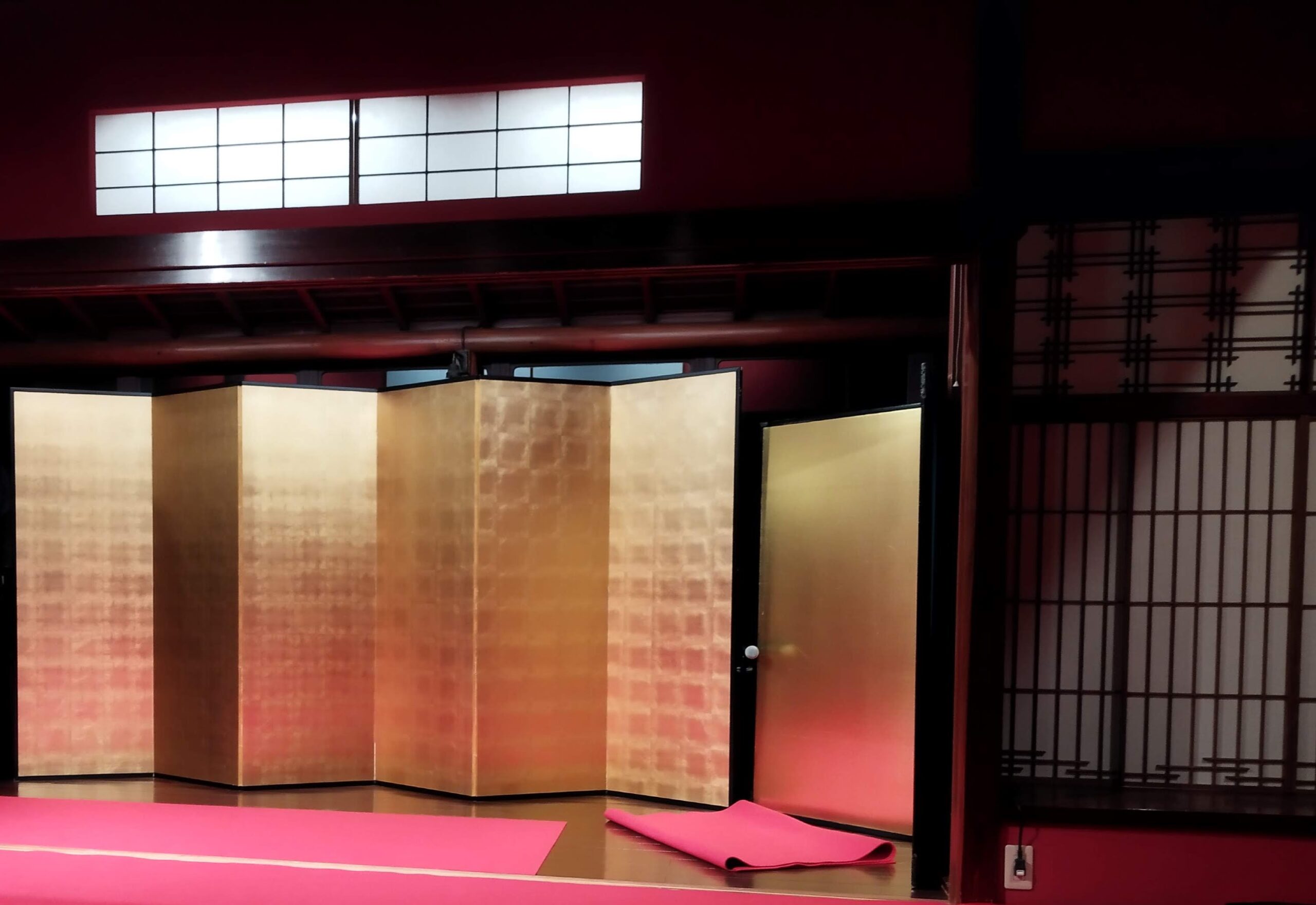本ブログではインバウンド(訪日外国人)ビジネスだけでなく企業接待や留学生対応で英語案内が必要ながら、多忙で情報収集に中々時間をかけられない方々の為に、すぐに使える情報をわかりやすく解説しています。
今回は『《ひがし茶屋街》わかりやすく解説』ブログの《3.お茶屋/芸者遊び》パートの英語案内用『演習音声ツール』です。本シリーズは上級者(日→英と英→日の双方向の対応が必要な方)向けツールとなります。
前書き:『演習音声ツール』について(⭐令和5年9月更新版)
このブログでは下記4タイプ(A〜D)、合計13モデルの音声合成音を使った英語案内の為の演習ツールをご用意していますが、今回テーマ《ひがし茶屋街❸》では(A~C)合計10モデルがご利用可能です。ご自分の好みと必要度に合わせて目次からピンポイントでお試しください。ニーズが高いモデルから順次ツール化していますので、音声がないものは少々お待ち下さい。各パートの冒頭に《Glossaries:用語集》もあります。👉ツールについて詳細確認されたい場合は別途『演習ツール』ご参照ください。
- A 『日本語』から”英語”
- A1:基本/A2:口頭即訳/A3:逐次通訳/A4:同時通訳
- B ”英語”から『日本語』
- B1:基本/B2:口頭即訳/B3:逐次通訳/B4:同時通訳
- C ”英語”で質問と回答
- C1:基本/C2:口頭即訳
3. お茶屋/芸者遊び
今回ツールも本編ブログの表現から(口頭演習しやすいように)編集してあり、本編ブログと異なる部分がありますのでご注意ください。
3.1 基本情報
実際にインバウンドをご案内する前に押さえておきたい基本ポイントです。口頭演習ツール用に少し編集しています。👉長いですが、日本語(アナウンサー調女性)、英語(米国女性標準タイプ)とも各1ファイルに纏めました。
A 『日本語』から”英語”への置き換え
A1:基本モデル(音声:日英)
👉日本語と英訳文のセット全文を聴いて全体把握します。
A2:口頭即訳モデル(音声:日+ポーズ)
👉日本語の後の無音(ポーズ)の間にご自分の英訳が試せます。(A1の英語文がないタイプです。)
A3:逐次通訳モデル(音声:日)
👉日本語全文を最後まで聴いて(メモ可)、英訳が試せます。長めの日本語説明の後にインバウンドにわかりやすく簡潔に伝えるシチュエーションです。
A4:同時通訳モデル(音声:日:低速)
👉日本語から少し遅れてそのまま並走して英訳が試せます。約260文字/分(約85%低速)版
B ”英語”から『日本語』への置き換え
B1:基本モデル(音声:英日)
👉英文と和訳文のセット全文を聴いて全体把握します。
B2:口頭即訳モデル(音声:英+ポーズ)
👉英語の後の無音(ポーズ)の間に和訳ができます。(B1の日本語文がないタイプです。)
B3:逐次通訳モデル(音声:英)
👉英語全文を最後まで聞いて(メモ可)、和訳を試せます。インバウンドの長めの英語発言の後に日本人スタッフにわかりやすく簡潔に伝えるシチュエーションです。
B4:同時通訳モデル(音声:英:低速)
👉英語から少し遅れてそのまま並走して和訳できます。
《日本語例》
- かつては多くのお茶屋があったが、現在も営業しているお茶屋は限られています。
- 現在でも、一見さんお断りと、財布不要のつけ払いの基本ルールは生きています。
- お客が支払わない場合は、紹介者が負担しなければならない、典型的な信用ビジネスです。
- 一部のお茶屋は一般公開されていて外人向けショーをしたり、他方では美術館となっているものもあります。
- 京都にも多くのお茶屋はありますが、殆ど非公開なので、ここで内部が観れるのは貴重な体験です。
- 建物は約2世紀前に出来た頃のままで、当時のお茶屋と芸者が接待した雰囲気が味わえます。
- 2階は得意客の接待用に、1階は女将や芸姑衆様に使われていました。
- また、階段を得意客用と従業員用に分け、従業員の日常を客が目撃しないようにしました。
- その為、2階は豪華な造りで音響を考慮し天井が高く、階段は吹き抜けになっています。
- 得意客は座敷に床の間を背にして座り、ゲイコは襖越しに見える隣の小部屋で演奏をします。
- 頃合いを見計らって襖を舞台の幕のように開け、待ち構えていた芸妓の演奏が始まります。
- お茶屋は社交の場だったので、台所では料理をせず、仕出し屋からを取っていました。
- お茶屋の表通り側の外壁は、特殊な格子窓で覆われ、外から中が見えないようになっています。
- お茶屋の柱のほとんどは、腐食を防ぎ、光沢を増すために漆が塗られています。
- 更に落ち着いた雰囲気を出す為に建物の内外に独特の赤みのあるベンガラ(紅殻)が塗られています。
- 当時は芸妓の芸だけでなく、客自身が芸を披露し、時には酒を飲まされる罰ゲームもあり、文化交流の場でもありました。
- 特に金沢の芸妓は座敷で太鼓の芸を披露し、時には客を招いて一緒に太鼓を叩きました。
《英訳例》
- There used to be many teahouses, but only a few are still in business today.
- Even today, the basic rules of ‘no first-time visitors’ and ‘no-wallet visit and pay later’ still apply.
- If the customer does not pay, the introducer must pay, a typical credit business.
- While some teahouses are open to the public, and offer performances for foreign visitors, others have been converted into museums.
- There are also many teahouses in Kyoto, but most of them are closed to the public, so it is a rare experience to be able to see the inside of a teahouse here.
- The building is as it was when it was built about two centuries ago, and you can enjoy the atmosphere of the teahouse and the geisha who entertained guests in those days.
- The second floor was used for entertaining customers, while the first floor was used for the proprietress and geisha staff.
- The staircase was also divided into two sections, one for customers and one for staff, to ensure that customers did not witness the daily routines of employees.
- Therefore, the second floor is luxurious, with a high ceiling for acoustics and The staircase is a stairwell.
- Guests sit in the tatami room with their backs to the alcove, while a Geiko, a traditional Japanese entertainer, performs in a small room next door, visible through the sliding doors.
- When the time is right, the sliding door is opened like a stage curtain, and Geiko, who has been waiting, begins to play.
- Because the teahouse was a social place, the kitchen did not cook, but took food from a caterer.
- The outer walls on the street side of the teahouse are covered with special lattice windows, preventing outsiders from seeing inside.”
- Most of the pillars in the teahouse are coated with lacquer to prevent corrosion and add luster.
- To create a more relaxed atmosphere, the inside and outside of the building are coated with a unique reddish ben-ga-ra (red shell).
- In those days, in addition to geiko performances, the guests themselves performed tricks and were sometimes punished by being forced to drink sake, making it a place for cultural exchange.
- In particular, Kanazawa geiko performed the art of taiko drumming in the tatami room, and sometimes invited guests to join in and beat the drums with them.
3.1 インバウンドの視点
ここではインバウンドが《お茶屋》の中を見ながら、素朴に感じるであろう想定疑問と回答例をご紹介しますが、今回は日本人への興味に関するやりとりを主体に纏めています。以下日英順です。
《想定質問》
- ここで何をしていたんですか?
- どうして、お茶屋が使われなくなったのですか?
- よくある町家と何が違うんですか?
- 芸者は結婚できるのですか?
- 芸者は何歳くらいまでできるのですか?
- 台所ではどんな料理を作っていたのですか?
- お茶屋は何時頃まで営業していたのですか?
- What were people doing here?
- Why was the teahouse no longer used?
- What makes it different from a typical townhouse?
- Could geisha get married?
- How old can a geisha be?
- What kind of food was prepared in the kitchen?
- Until what time did the ochaya stay open?
上記に対する回答例です。
- ここでは、お金持ちや文化人たちが毎晩、芸者を交えてお茶屋遊びという和式パーティをしていました。
- 元々、上流階層の特定の人々のお遊びだったので、民主化の波と大衆的な遊びの普及で、絶滅危惧種となりました。
- 一般的に町家は日常生活の場でしたが、お茶屋は会員制の社交の場でした。
- 地域によりますが、金沢では基本的に結婚後も芸者は続けられました。
- 特に定年はありませんので、アメリカ大統領より年上の現役芸者もいます。
- お茶屋の台所ではお酒の用意をするだけで、何も料理されませんでした。
- 一般的に特に閉店時間は決まっておらず、朝帰りするお客もいました。
- Here, the rich and cultured people had nightly Japanese-style parties called o-cha-ya play with geisha.
- Originally a pastime for certain members of the upper class, it became an endangered species with the wave of democratization and the spread of popular games.
- Generally, the machiya was a place for daily life, while the teahouse was a place for socializing with a membership system.
- Although it depended on the region, in Kanazawa, geishas basically continued to work after marriage.
- There is no specific retirement age, so some geisha are older than the President of the United States.
- In the ochaya kitchen, nothing was cooked except for the preparation of sake.
- In general, there was no specific closing time, and some customers would leave in the morning.
3.3 笑いが取れるかも? 説明例
a)そもそも、ここでは何をしていたのですか?
What were people doing here in the first place?
言うまでもなく、こんな表現で、かつ長セリフを求められることは現実的にあり得ませんが、いつも通り、日常生活でも使えそうな、多様な表現を試して頂いて、お好みあれば現場でもご活用ください。
- お茶屋と言っても、ここでティーパーティをしていたわけではありません。
- ここにはパトロンから紹介されたお客だけが入れる秘密サロンのようなものです。
- この広い、金屏風と床の間とあるお座敷がお客様専用の部屋になります。
- そこでお酒や仕出し料理を味わいながら、隣の控えの間で披露される芸者の芸を楽しむのです。
- 又、それは一方的なショーでなく、一緒に太鼓をたたいたり、ゲームをしたりして芸者と少人数で盛り上がるのです。
- ただ、ここは密室でなく、同じ二階の別の座敷でも他のお客が芸者遊びをしていて、通りを挟んだ向かいの茶屋からも演奏が聞こえたことでしょう。
- 一見さんお断りルールで限定客だけの隠れ屋と思ってましたが、実は自分たちのお茶屋遊びはまる聞こえなわけですね。
- でも、それってアリバイ作りのようなもので、芸者の演奏中は、お客がどこか他に消えていてもわからない。
- つまり、お茶屋遊びの神髄と2百年以上も続いた訳はそこにあったのでは?
《英訳例》
- Although it is called a teahouse, this is not a place where tea parties were held.
- This is a kind of secret salon where only customers introduced by patrons are allowed.
- This spacious tatami room with a gold folding screen and an alcove is reserved for guests.
- There, guests savor sake and catered dishes while enjoying the geisha performances in the adjoining antechamber.
- This is not a one-way show, but rather a small group of people who enjoy the company of the geisha by beating taiko drums and playing games together.
- However, this was not a closed room. There were other guests playing with the geisha in another room on the same second floor, and the performance could have been heard from the teahouse across the street.
- I thought the teahouse was a hideaway for only a limited number of guests due to the “no first-time visitors” rule, but in fact, their own teahouse games could be heard all the way in the background.
- But that might have been just like creating an alibi. While the geisha were playing, the customers could pretend to have been there even if they disappeared somewhere else.
- In other words, wasn’t that the essence of the teahouse game and the reason it lasted for over two hundred years?
御礼🔶後書き
🔶今回も最後まで読んで頂き大変ありがとうございます。もし何かご意見やリクエストございましたらお気軽に『Help Desk』にてお声がけくださいませ。Gold🔶



コメント